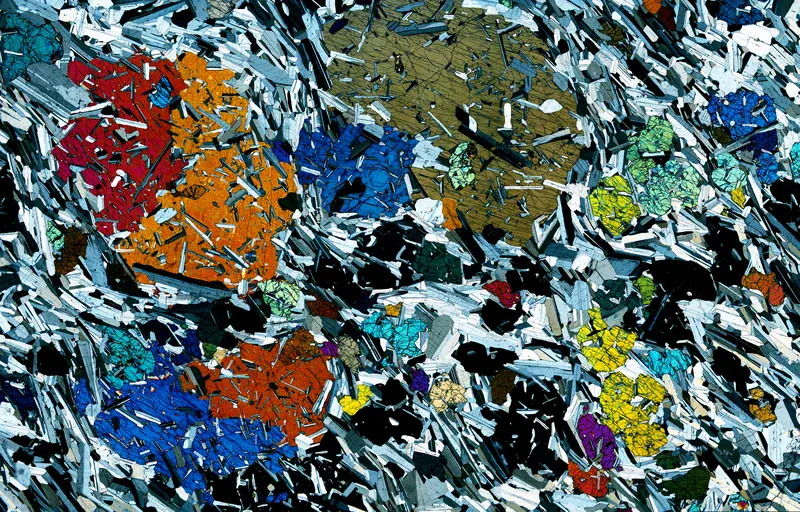
Cooking crystals in the Earth cauldron
by Julien Leuthold, ETH Zürich, Switzerland
This picture shows a 30 micrometers thick rock section of a gabbro from the Rum Layered Intrusion (Scotland). Large clinopyroxene crystals are enclosed in a foliated fine grained groundmass of plagioclase and olivine. The clinopyroxene core crystallized at an early stage, at 1160°C. They were partly molten at 1200°C during successive hot magma injections and subsequently recrystallized, enclosing heat resistant groundmass crystals. This process is opposite to the classical view of cooling and crystallizing magmas. As a result, secondary minerals such as spinel were saturated and subsequently absorbed PGE ore.
It has taken millions of year to form a rigid crust at the Earth surface, progressively built up by cooling lavas. Just imagine how apocalyptic it must have been! Today, we still find magma in the partially molten inner parts of the Earth, which erupts periodically and give a brief idea of such past time.
60 Millions years ago, huge eruptions were taking place in Scotland… One of the volcano looked like a huge cauldron, 4km in diameter and 1km deep. It was heated at extreme conditions, by hundreds of lava injections directly coming from the deep Earth at 1250°C. Early cooled rocks were being re-molten, in a fight between crystallization and melting. The crystals were deformed and their composition was changed during heating, cooling and compaction.
The Scottish wind and rain have finally frozen the cauldron and started to erode it. Valleys now offer access to its deep parts, where we can read a fantastic tale, written of crystal letters! And who knows… a similar story may start tomorrow in Iceland…
This is a stitched image of a 4x2cm sample, acquired with a Nikon Eclipse LV100-UDM-POL microscope, under cross polarized light.
Featured on GeoLog, the official blog of the European Geosciences Union
Categories
Location
Tags
Colours
Image properties
5000 × 3199 px;
image/tiff; 45.8 MB
Camera:
Nikon Nikon Eclipse LV100-UDM-POL microscope
Taken on 16
April
2012
Submitted on 10 February 2018
Licence
Creative Commons Attribution 3.0 Unported (CC BY 3.0)
Credit
Julien Leuthold (distributed via imaggeo.egu.eu)
Share
Appreciate
Report
Elizaveta Kovaleva 7 years, 9 months ago
Love the colors!